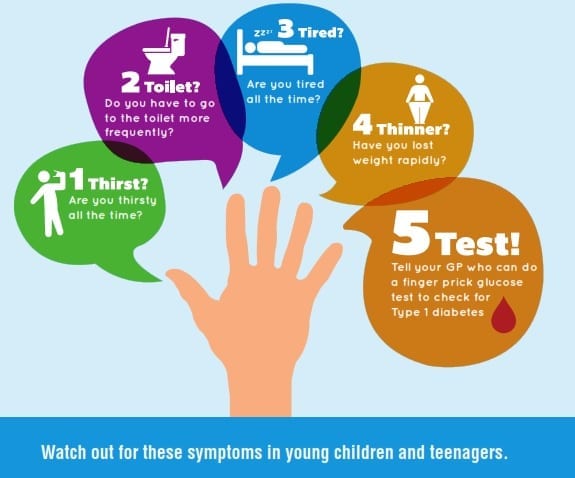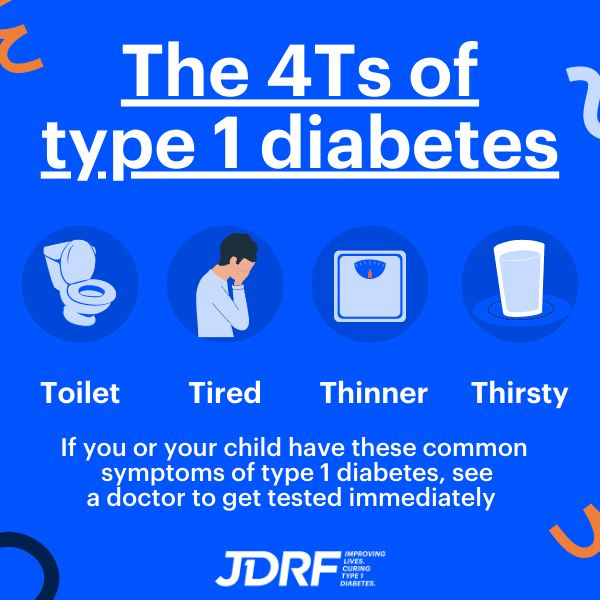Type 1 diabetes is a serious condition that affects how your body processes sugar. Recognizing its signs and symptoms early is crucial.
Type 1 diabetes, often diagnosed in children and young adults, occurs when the pancreas produces little or no insulin. Insulin is essential for getting sugar from the bloodstream into the cells for energy. Without it, sugar builds up in the blood, leading to various health issues.
This blog will discuss the common signs and symptoms of Type 1 diabetes. Knowing these can help in seeking timely medical advice and managing the condition effectively. Early detection is key to preventing complications. Stay informed and learn what to watch for.
Early Warning Signs
Recognizing the early warning signs of Type 1 Diabetes is crucial. These signs can help in timely diagnosis and management. Early detection can prevent severe complications. Here are some key early warning signs to watch out for.
Frequent Urination
Frequent urination is often the first noticeable sign. When blood sugar levels are high, the kidneys try to remove the excess sugar by filtering it out of the blood. This leads to increased urination.
| Sign | Description |
|---|---|
| Frequent Urination | More trips to the bathroom, especially at night. |
Frequent urination can also lead to dehydration. This can cause even more symptoms, such as feeling thirsty all the time.
Increased Thirst
Feeling unusually thirsty is another early sign. Due to the frequent urination, the body loses more water. This increases the need to drink fluids to stay hydrated.
- Persistent Thirst: Even after drinking water, the thirst remains.
- Dry Mouth: A dry mouth or throat is common.
These symptoms can disrupt daily life. Recognizing them early can lead to prompt medical attention. Monitoring these signs can make a significant difference in managing Type 1 Diabetes.
Stay aware and consult a healthcare professional if you notice these signs. Early detection and management are key to living well with Type 1 Diabetes.
Common Symptoms
Type 1 Diabetes often shows clear signs and symptoms. Recognizing these early can help manage the condition better. Let's explore some common symptoms that may indicate Type 1 Diabetes.
Extreme Hunger
People with Type 1 Diabetes often feel very hungry. The body cannot use glucose properly, so it signals for more food. This hunger can be intense and frequent.
Unintended Weight Loss
Despite eating more, people with Type 1 Diabetes may lose weight. The body starts to burn muscle and fat for energy. This happens because it cannot use glucose properly. Weight loss can be sudden and unexplained.
Visible Skin Changes
Type 1 Diabetes can lead to several visible skin changes. These changes can be early signs of the condition. Paying attention to your skin can help you catch these signs early. Below are some common skin changes linked to Type 1 Diabetes.
Dry Skin
Dry skin is a common sign of Type 1 Diabetes. The condition can affect your body’s ability to retain moisture. This can make your skin feel rough or flaky. You may notice dry patches on your elbows, knees, or feet. Keeping your skin hydrated is essential. Use a good moisturizer daily. Drink plenty of water. This can help keep your skin soft and smooth.
Slow-healing Sores
Sores that take a long time to heal can be a sign of Type 1 Diabetes. High blood sugar levels can affect your blood flow. This makes it harder for your body to heal wounds. You may notice cuts or bruises that linger. This can be a serious issue. Poor wound healing can lead to infections. Always clean and protect any cuts or sores. Seek medical help if they do not heal in a reasonable time.
Vision Problems
Type 1 Diabetes can lead to various complications. One common issue is vision problems. High blood sugar levels can harm your eyes. This damage can cause several symptoms.
Blurry Vision
Blurry vision is a frequent sign of Type 1 Diabetes. High blood sugar can cause the lens of your eye to swell. This swelling changes the way you see. You may find it hard to focus on objects. Reading or driving can become difficult. If you notice this symptom, contact your doctor.
Eye Pain
Eye pain is another symptom of Type 1 Diabetes. High blood sugar can lead to inflammation in the eye. This can cause discomfort or pain. Sometimes, the pain can be sharp. Other times, it can be dull and persistent. If you feel any eye pain, seek medical help immediately.
Nerve Complications
Living with Type 1 Diabetes can lead to various complications, one of which is nerve damage. High blood sugar levels can harm the nerves in your body. This can cause a range of symptoms that affect your daily life. It's essential to recognize these signs early to manage them effectively.
Tingling Sensation
A common sign of nerve damage is a tingling sensation. You might feel this in your hands, feet, or other parts of your body. This sensation often feels like pins and needles and can be uncomfortable.
Here are some key points to note:
- Occurs mainly in the extremities
- Can be mild or severe
- May worsen at night
Numbness
Numbness is another symptom of nerve complications. You might lose feeling in parts of your body. This can make it hard to sense temperature changes or pain. Numbness often starts in the toes and fingers.
Important aspects of numbness include:
- Loss of sensation
- Increased risk of injuries
- Difficulty with balance and coordination
Understanding these symptoms can help you take steps to manage your Type 1 Diabetes better. If you notice these signs, consult your healthcare provider for advice.

Credit: www.diabetes.ie
Extreme Fatigue
Extreme Fatigue is a common sign of Type 1 Diabetes. Many individuals with Type 1 Diabetes experience overwhelming tiredness. This tiredness can affect daily activities and overall quality of life.
Constant Tiredness
People with Type 1 Diabetes often feel constant tiredness. This tiredness does not go away after rest. It can make it difficult to concentrate or perform simple tasks. The body struggles to use glucose for energy. This leads to a lack of fuel, causing tiredness.
Here are some common signs of constant tiredness:
- Difficulty waking up in the morning
- Falling asleep during the day
- Feeling lethargic even after sleep
Weakness
Weakness is another sign of extreme fatigue in Type 1 Diabetes. Weakness can make muscles feel heavy. It can make it hard to move or exercise. The body lacks the energy to support physical activities. This can be frustrating and limit daily life.
Signs of weakness include:
- Difficulty lifting objects
- Struggling with physical tasks
- Feeling faint or dizzy
| Symptom | Description |
|---|---|
| Constant Tiredness | Persistent fatigue, even after sleep |
| Weakness | Reduced muscle strength and energy |
Mood Swings
Type 1 Diabetes can impact both physical health and emotional well-being. One significant effect is mood swings. These emotional changes can make daily life more challenging. Understanding the signs can help manage these mood swings better.
Irritability
Irritability is a common sign of mood swings in Type 1 Diabetes. Blood sugar levels that are too high or too low can lead to irritability. Simple tasks might seem overwhelming. This can affect relationships with family and friends.
Managing blood sugar can help reduce irritability. Regular monitoring is key. It helps in maintaining a stable mood. A balanced diet and regular exercise also play a role.
Sudden Mood Changes
Sudden mood changes can occur without warning. One moment, you might feel happy. The next, you could feel sad or angry. These shifts can be confusing. They are often linked to fluctuating blood sugar levels.
Being aware of these changes can help in managing them. Keeping a journal can track triggers. This can aid in identifying patterns. Seeking support from healthcare professionals is also beneficial.
When To See A Doctor
Recognizing the signs and symptoms of Type 1 Diabetes early can be life-saving. Knowing when to see a doctor can help manage the condition effectively. Pay attention to the following guidelines to ensure timely medical intervention.
Emergency Signs
Some symptoms require immediate medical attention. These include:
- Extreme thirst and frequent urination
- Unexplained weight loss
- Persistent fatigue
- Blurry vision
- Fruity-scented breath
If you or someone you know experiences these symptoms, seek medical help right away. Early detection can prevent severe complications.
Regular Screenings
Regular screenings are crucial for individuals at risk. Schedule periodic check-ups if you have:
- A family history of diabetes
- Frequent infections
- Slow-healing sores
Screenings can help detect the condition early and manage it effectively.
Monitoring blood sugar levels is also essential. Use a glucose meter to keep track of your blood sugar levels. Regular monitoring helps in adjusting your treatment plan as needed.
| Symptom | When to See a Doctor |
|---|---|
| Extreme thirst | Immediately |
| Unexplained weight loss | Immediately |
| Persistent fatigue | Immediately |
| Blurry vision | Immediately |
| Family history of diabetes | Regular screenings |
Stay aware of these signs and symptoms. Regular medical check-ups and immediate attention to emergency signs can make a significant difference in managing Type 1 Diabetes.

Credit: jdrf.org.au
Frequently Asked Questions
What Are The Early Signs Of Type 1 Diabetes?
Early signs include frequent urination, increased thirst, and sudden weight loss. Fatigue and blurred vision can also occur.
How Is Type 1 Diabetes Diagnosed?
Type 1 Diabetes is diagnosed through blood tests measuring glucose levels. A1C tests and fasting glucose tests are commonly used.
Can Children Develop Type 1 Diabetes?
Yes, Type 1 Diabetes often develops in children and young adults. It's essential to monitor symptoms early.
What Causes Type 1 Diabetes?
Type 1 Diabetes is caused by the immune system attacking insulin-producing cells. The exact cause is unknown.
Conclusion
Understanding the signs and symptoms of Type 1 Diabetes is crucial. Early detection helps manage the condition better. Watch for unusual thirst, frequent urination, and sudden weight loss. These signs often indicate a problem. Consult a doctor if you notice these symptoms.
Proper diagnosis and treatment can improve life quality. Stay informed and take care of your health. By recognizing these signs, you can act swiftly. Early action makes a big difference. Remember, knowledge is power when managing diabetes. Stay healthy and vigilant.






